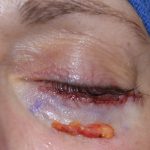Aging of the lower eyelid is typified by excessive skin and wrinkles and herniated infraorbital fat. It is this fat that often gives the appearance of lower eyelid bags and puffiness which is always greatest in the morning. This fat is typically removed, in varying amounts, in the commonly performed lower blepharoplasty. While making a dramatic improvement in the short-term, aging and further fat atrophy can create a diametric aesthetic result long-term with a sunken or skeletonized appearance if aggressive fat removal is done.
Today’s lower blepharoplasty surgery places an emphasis on three considerations; more fat retention with redistribution, less skin and muscle removal, and attention to lateral canthal tendon support. It is the idea of redistributing the infraorbital fat rather than simply removing it that has multiple aesthetic benefits. By removing the bulging areas of fat and moving it into the tear trough indentation below, a smoother lid-cheek junction results.

If one is young and herniated fat is the only issue, then fat removal and transposition is all that is done. If not, then some skin excision is done below the lash line fora few millimeters but no muscle is removed. This allows a good blood suply to be maintained to the lower eyelid skin. Once this incision is closed, then a 30% Trichloroacetic acid (TCA) peel is done. The peel is applied from just beyond the lid-cheek junction up to lose to the suture line under the eyelashes.
Only in those patients with some laxity to the lower eyelid, or some scleral show, get treated as the last step with a lateral canthopexy or tendon tightening procedure. This is usually older patients greater than 60 years of age.
Treatment of the tear trough with the creation of a smoother lid-cheek junction is an important goal in lower blepharoplasty today. This newer transconjunctival approach to the lower eyelid has much less risks for complication such as ectropion. (lower eyelid pulling away or down from the eyeball) It also produces a more natural result as the goal is not to see how much skin and fat can be removed or to make the lower eyelid as tight as possible.
Dr. Barry Eppley
Indianapolis, Indiana


